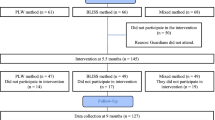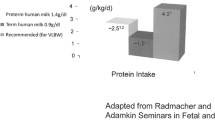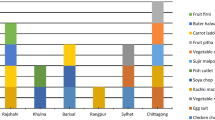Abstract
The paradigm of the first 1000 days of life, the period from conception to the second birthday, has been advanced as a critical window of opportunity to save a life and a child’s future. Infancy and toddler life, through the first 24 months after birth, is a unique period during which human milk is recommended as either the exclusive source of nutrition (6 months) or a variable component thereof. After the maternal delivery of milk is accounted for, the remainder of the energy and nutrients needs come from complementary foods. There is an intrinsic gap left by the maternal milk supply in volume and micronutrient content in relation to expanding infant and toddler needs. The nutrient density approach provides us with a mathematical framework to manage the closing of the nutrient gap. The intrinsic nutrient content of the unprocessed foods appropriate for young children is limited. The most problematic nutrients are calcium, iron and zinc. Some manner to enhance the nutrient density of the complementary foods is an incontestable necessity. The nutrient density consideration, which identifies for us the nature of the problem, offers a tool for the titrating of the fortification to an adequate—but safe—addition.
This is a preview of subscription content, access via your institution
Access options
Subscribe to this journal
Receive 12 print issues and online access
$259.00 per year
only $21.58 per issue
Buy this article
- Purchase on Springer Link
- Instant access to full article PDF
Prices may be subject to local taxes which are calculated during checkout

Similar content being viewed by others
References
Food Nutrition Board. Recommended Dietary Allowances 10th edn National Academies Press: Washington, DC, USA, 1989.
King JC . Doris Howes Calloway (1923–2001). J Nutr 2003; 133: 2113–2116.
Allen L, De Benoist B, Dary O, Hurrell R . Guidelines on Food Fortification with Micronutrients. World Health Organization and Food and Agriculture Organization of the United Nations: Geneva, Switzerland, 2006.
Chen SY, Lin JR, Chen TH, Guo SG, Kao MD, Pan WH . Dietary supplements usage among elderly Taiwanese during 2005–2008. Asia Pac J Clin Nutr 2011; 20: 327–336.
Gahche J, Bailey R, Burt V, Hughes J, Yetley E, Dwyer J et al. Dietary supplement use among U.S. adults has increased since NHANES III (1988–1994). NCHS data brief, no 61. National Center for Health Statistics: Hyattsville, MD,, 2011.
Murphy SP, Wilkens LR, Monroe KR, Steffen AD, Yonemori KM, Morimoto Y et al. Dietary supplement use within a multiethnic population as measured by a unique inventory method. J Am Diet Assoc 2011; 111: 1065–1072.
Fulgoni VL, Keast DR, Bailey RL, J Dwyer . Foods fortificants, and supplements: where do Americans get their nutrients? J Nutr 2011; 141: 1847–1854.
US Department of Agriculture (updated 2012); USDA National Nutrient Database for Standard Reference. Release 18. Nutrient Data Laboratory Home Page, 2012. Available at: http://www.nal.usda.gov/fnic/foodcomp/Data/ (accessed on June 2012).
Institute of Medicine. Dietary Reference Intakes for Calcium, Phosphorus, Magnesium, Vitamin D and Fluoride. National Academy Press: Washington, DC, USA, 1997.
Institute of Medicine. Dietary Reference Intakes for Thiamine, Riboflavin, Niacin, Vitamin B6, Folate, Vitamin B12, Pantothenic Acid, Biotin, and Choline. National Academy Press: Washington, DC, USA, 1998.
Institute of Medicine. Dietary Reference Intakes for Vitamin C, Vitamin E, Selenium, and Carotenoids. National Academy Press: Washington, DC, USA, 2000.
Institute of Medicine. Dietary Reference Intakes for Vitamin A, Vitamin K, Arsenic, Boron, Chromium, Copper, Iodine, Iron, Manganese, Molybdenum, Nickel, Silicon, Vanadium, and Zinc. National Academy Press: Washington, DC, USA, 2001.
Institute of Medicine. Dietary Reference Intakes for Energy, Carbohydrate, Fiber, Fat, Fatty Acids, Cholesterol, Protein, and Amino Acids. National Academy Press: Washington, DC, USA, 2005.
WHO, FAO. Vitamin and Mineral Requirements in Human Nutrition 2nd edn World Health Organization, Food and Agriculture Organization: Geneva, Switzerland, 2004.
FAO/WHO/UNU. Human energy requirements. Report of a Joint FAO/WHO/UNU Expert Consultation, 17–24 October 2001, Rome, Italy 2004.
WHO. Protein and amino acid requirements in human nutrition. Report of a joint FAO/WHO/UNU Expert Consultation (WHO Technical Report Series no. 935), World Health Organization: Geneva, Switzerland, 2007.
Mertz W . The essential trace elements. Science 1981; 213: 1332–1338.
Sen A . Poverty and Famines: An essay on entitlements and deprivation. Clarendon Press: Oxford, UK, 1982.
McMichael AJ . Insights from past millennia into climatic impacts on human health and survival. Proc Natl Acad Sci USA 2012; 109: 4730–4737.
Torheim LE, Ferguson EL, Penrose K, Arimond M . Women in resource-poor settings are at risk of inadequate intakes of multiple micronutrients. J Nutr 2010; 140: 2051S–2058S.
Hadley C, Maes K . A new global monitoring system for food insecurity? Lancet 2009; 374: 1223–1224.
Atinmo T, Mirmiran P, Oyewole OE, Belahsen R, Serra-Majem L . Breaking the poverty/malnutrition cycle in Africa and the Middle East. Nutr Rev 2009; 67 (Suppl 1), S40–S46.
Lutter CK, Rivera JA . Nutritional status of infants and young children and characteristics of their diets. J Nutr 2003; 133: 2941S–2949SS.
Hall KD, Heymsfield SB, Kemnitz JW, Klein S, Schoeller DA, Speakman JR . Energy balance and its components: implications for body weight regulation. Am J Clin Nutr 2012; 95: 989–994.
1000 Days. 1,000 Days: change a life, change the future. Available at: http://www.thousanddays.org/ (updated 2011; accessed on 10 May 2011).
Victora CG, de Onis M, Hallal PC, Blossner M, Shrimpton R . Worldwide timing of growth faltering: revisiting implications for interventions. Pediatrics 2010; 125: e473–e480.
Dewey KG, Begum K . Long-term consequences of stunting in early life. Matern Child Nutr 2011; 7 (Suppl 3), 5–18.
WHO. Global Strategy for Infant and Young Child Feeding. World Health Organization: Geneva, Switzerland, 2003.
Wuehler SE, Hess SY, Brown KH . Accelerating improvements in nutritional and health status of young children in the Sahel region of Sub-Saharan Africa: review of international guidelines on infant and young child feeding and nutrition. Matern Child Nutr 2011; 7 (Suppl 1), 6–34.
van der Merwe J, Kluyts M, Bowley N, Marais D . Optimizing the introduction of complementary foods in the infant’s diet: a unique challenge in developing countries. Matern Child Nutr 2007; 3: 259–270.
Brown KH, Dewey KG, Allen LH . Complementary Feeding of Young Children in Developing Countries: a Review of Current Scientific Knowledge. WHO: Geneva, Switzerland, 1998.
Allen LH . B vitamins: proposed fortification levels for complementary foods for young children. J Nutr 2003; 133: 3000S–3007S.
World Alliance for Breastfeeding Action (WABA). Protecting, Promoting and Supporting Continued Breastfeeding from 6 to 24+Months: Issues, Politics, Policies and Action 2008.
International Baby Food Action Network (IBFAN). What is complementary feeding? A philosophical reflection to help a policy process. A discussion paper developed for the International Baby Food Action Network (IBFAN) by Gabrielle Palmer, 2009. Available at: http://www.ibfan.org/Gay_Palmer.html (accessed on May 2012).
WHO Multicenter Growth Reference Study Group. WHO Child Growth Standards: Methods and Development. World Health Organization: Geneva, Switzerland, 2006.
Dewey KG, Brown KH . Update on technical issues concerning complementary feeding of young children in developing countries and implications for intervention programs. Food Nutr Bull 2003; 24: 5–28.
WHO. Preparation and Use of Food-Based Dietary Guidelines. Report of a Joint FAO/WHO Consultation. Technical Report Series No. 880, World Health Organization: Geneva, Switzerland, 1998.
Vossenaar M, Solomons NW . The concept of ‘critical nutrient density’ in complementary feeding: the demands on the ‘family foods’ for the nutrient adequacy of young Guatemalan children with continued breastfeeding. Am J Clin Nutr 2012; 95: 859–866.
Lutter CK, Dewey KG . Proposed nutrient composition for fortified complementary foods. J Nutr 2003; 133: 3011S–3020S.
Dewey KG . Increasing iron intake of children through complementary foods. Food Nutr Bull 2007; 28: S595–S609.
Nestel P, Briend A, de Benoist B, Decker E, Ferguson E, Fontaine O et al. Complementary food supplements to achieve micronutrient adequacy for infants and young children. J Pediatr Gastroenterol Nutr 2003; 36: 316–328.
Brown KH . Breastfeeding and complementary feeding of children up to 2 years of age. Nestle Nutr Workshop Ser Pediatr Program 2007; 60: 1–10.
Ferguson EL, Darmon N . Traditional foods vs. manufactured baby foods. Nestle Nutr Workshop Ser Pediatr Program 2007; 60: 43–63.
Allen LH . Adequacy of family foods for complementary feeding. Am J Clin Nutr 2012; 95: 785–786.
Ross AC, Taylor CL, Yaktine AL, Valle HBD (eds) Institute of Medicine (US) Committee to Review Dietary Reference Intakes for Vitamin D and Calcium. National Academies Press: Washington, DC, 2011.
Author information
Authors and Affiliations
Corresponding author
Ethics declarations
Competing interests
The authors declare no conflict of interest.
Rights and permissions
About this article
Cite this article
Solomons, N., Vossenaar, M. Nutrient density in complementary feeding of infants and toddlers. Eur J Clin Nutr 67, 501–506 (2013). https://doi.org/10.1038/ejcn.2013.46
Received:
Accepted:
Published:
Issue Date:
DOI: https://doi.org/10.1038/ejcn.2013.46
Keywords
This article is cited by
-
Ethnic inequalities and trends in stunting prevalence among Guatemalan children: an analysis using national health surveys 1995–2014
International Journal for Equity in Health (2019)
-
Towards appropriate feeding to prevent malnutrition in infants and toddlers
European Journal of Clinical Nutrition (2018)
-
Selection of complementary foods based on optimal nutritional values
Scientific Reports (2017)



